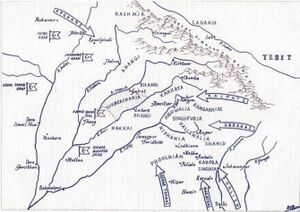Misl

Misl or Misal (Hindi:मिसल, Punjabi: ਮਿਸਲ) is the Persian word meaning "similar" or "alike", generally refers to the twelve sovereign states in the Sikh Confederacy. This is the widely accepted origin of the word. Joseph D. Cunningham raised the possibility in 1849 of the Persian word "Musluhut" meaning "warlike people" being the origin of "misl."[1]
History
In order to challenge the persecution of Sikhs at the hands of Jahangir who martyred the fifth Guru Guru Arjan Deva, Sixth Sikh Guru established the convention of keeping military forces. He and other Sikh Gurus fought the Mughal Empire and Hindu hill chiefs in the early and middle Mughal-Sikh Wars. Banda Singh Bahadur continued Sikh resistance to the Mughal Empire until his defeat at the Battle of Gurdas Nangal in 1715. Thereafter, for several years, Sikhs found refuge in the jungles and the Himalayan foothills until they organized themselves into military bands known as jathas or misls.
Organization
Each Misl was made up of a number of soldiers, whose leadership was given to the Misl's leader. A Misl could be composed of a few hundred to tens of thousands of soldiers. Every soldier was free to join any Misl he chose and free to cancel his membership of the Misl to whom he belonged. He could, if he wanted, cancel his membership of his old Misl and join another. The Barons would allow their armies to combine or coordinate their defences together against a hostile force if ordered by the Misldar Supreme Commander. These orders were only issued in military matters affecting the whole Sikh community. These orders would normally be related to defense against external threats, such as Afghan military attacks. The profits of a fighting action were divided by the misls to individuals based on the service rendered after the conflict using the sardari system.
List of misls
जाट जाति और सिख-धर्म
ठाकुर देशराज लिखते हैं: एक दिन जिस जाट जाति का आधे यूरोप और एशिया के प्रायः समस्त प्रदेश पर आतंक रहा था, एक समय उसी जाट जाति के लिए ऐसा भी आया कि वह शासन की बजाए शासित और असभ्य तथा सम्पत्तिशाली की जगह निर्धन समझी जाने लगी। इसका कारण यही था कि जिन तरीकों से उसने पिछले हजारों वर्षों से शासन किया था, वे अब फेल हो चुके थे। प्रजातंत्र का स्थान एकतंत्र ने ग्रहण कर लिया था। अब यह आवश्यक था कि सुदिन लाने के लिए इनकी मनोवृत्तियां बदली जातीं, किन्तु यह इन्हें पसन्द न था। हालांकि कुछेक उन्नत-मना जाट वीर एकतंत्र की ओर बढ़े और उन्होंने ‘]]Jat States|जाट राज्य]]’ कायम भी किये। किन्तु जाति का अधिक भाग, उनके इस कार्य की ओर से उदासीन रहा।
महाराज शालिवान हाला, शालेन्द्रजित, यशोवर्द्धन, अनंदपाल, सुभाषसेद, मश्कसेन आदि महावीर ऐसे ही जाटों में से थे, जिन्होंने अपनी महत्त्वाकांक्षाओं की पूर्ति और जाति-हित के लिए एकतंत्र शासन स्थापित किये। किन्तु सम्पूर्ण जाति की इस कार्य में सहानुभूति न होने से इन राज्यों ने दो-तीन शताब्दियां भी न पकड़ीं।
जाट-कौम क्षात्र तेज रखते हुए भी अपने दुःख दूर करने तथा देश की सेवा करने में असमर्थ हो रही थी और वह समय अति निकट आने वाला था कि ‘जाट-जाति’ सदैव के लिए अथवा एक लम्बे अरसे के लिए उस स्थान पर पहुंच जाती, जहां से उसका उठना असम्भव हो जाता। परमात्मा की कृपा से ऐसे वक्त गुरुनानक प्रकट हुए जिससे कि इस जाति में फिर से नवजीवन का संचार हो गया। गुरुनानक के प्रचारित धर्म का नाम सिख-धर्म प्रसिद्ध हुआ। जाट जाति को इस धर्म से भक्ति, शक्ति, ओज और राज भी सब कुछ प्राप्त हुए। यद्यपि अभी तक इन्होंने अपने पूर्व-गौरव को प्राप्त नहीं किया है, किन्तु फिर भी उन्होंने वो स्थान प्राप्त कर लिया है, जिस पर कोई भी योद्धा जाति सन्तोष कर सकती है।
कालांतर में औरंगजेब के अत्याचारों का प्रतिकार करने के लिये भक्त सिखों को घोड़े की पीठ और तलवारों की मूठ सम्हालनी पड़ीं। वे संगठित हो गये। यह संगठन उनका प्रारम्भ में मिसलों के रूप में था। मिसल अरबी शब्द है जिसका भावार्थ दल होता है। प्रत्येक दल का एक सरदार होता था। उस सरदार की अध्यक्षता में दल के लोग इकट्ठे होकर उनकी आज्ञा का पालन करते थे। इस प्रकार के बारह दल अथवा मिसलें थीं। इन मिसलों की संगठित बैठक का नाम
जाट इतिहास:ठाकुर देशराज, पृष्ठान्त-222
इन लोगों ने ‘गुरमता’ रख छोड़ा था। गुरमता का अर्थ ‘गुरु मन्त्रणा’ होता है। गोपनीय अथवा महत्त्वपूर्ण विषयों पर विचार करने के लिये जो परिषद् होती थी, उसी का नाम गुरमन्त्रणा अथवा गुरमता था। इस तरह से सिख जाटों ने वहीं से उत्थान किया, जहां से कि उनका पतन हुआ था। किन्तु अबकी बार की उनकी प्रजातंत्र-प्रणाली नये रंग और नये विधान की थी। गुरमता में मिसलों के सरदार बैठते थे और वे सरदार अपनी सरदारी अपनी भुजाओं के पराक्रम से प्राप्त करते थे। उन्हें पूर्ण स्वतन्त्रता थी कि चाहे जितने देश पर वे अपना अधिकार जमाएं और चाहे जो कोई सरदार बन बैठे, यदि शक्ति रखता हो। गुरमता में निश्चय हुए प्रस्तावों के मानने के लिये वे बाध्य थे। किन्तु वास्तव में वे स्वयं ही गुरमता थे। सिखों की इन बारह मिसलों में आठ मिसलें जाटों द्वारा संस्थापित हुई थीं। चूकि हमारे इतिहास का सम्बन्ध जाटों से है, इसलिये हम इन्हीं आठ मिसलों का वर्णन करेंगे। (जाट इतिहास:ठाकुर देशराज, पृष्ठ-223)
विस्तृत विवरण के लिए देखें:
•भंगी मिसल • मिसल रामगढ़िया • कन्हैया मिसल • नकिया मिसल • करोड़सिंह मिसल • फुलकियां मिसल • फैजलपुरिया मिसल या सिंहपुरिया मिसल • सुकरचकिया मिसल
See also
- History of the Jats/Chapter XI by Ram Swarup Joon
- 'Sikhs--Their Journey of Five Hundred Years' by Dr. Raj Pal Singh, Delhi 1999
- Jat History Thakur Deshraj/Chapter VII Part I (i): pp.222-232
External links
References
- ↑ Cave-Browne 1861, p. 368

